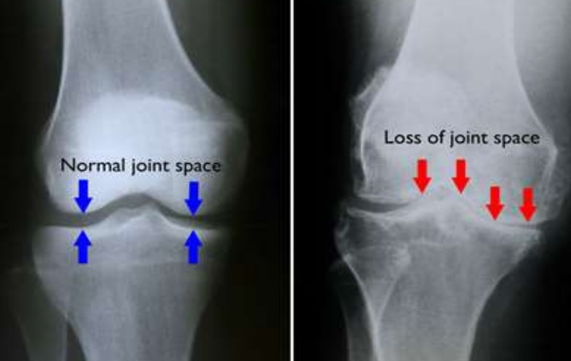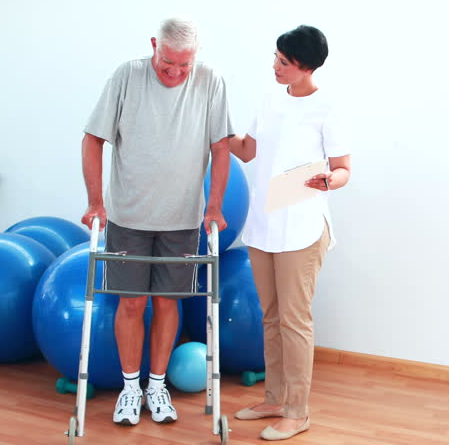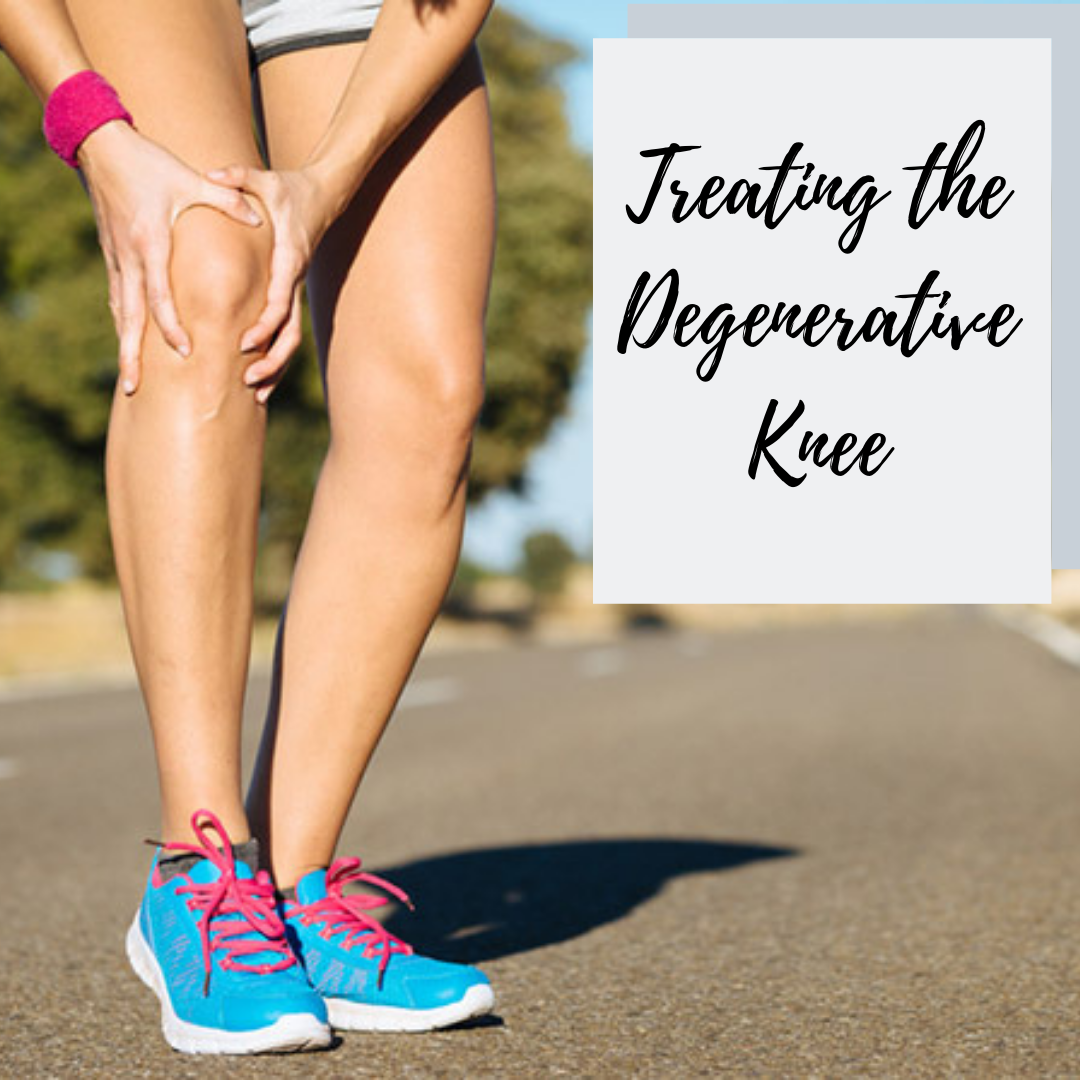Knee osteoarthritis is one of the leading causes of disability and is becoming more and more common. In knee osteoarthritis, the cartilage between your knees starts to wear away and the distance between the bones in your knees starts to decrease. The intensity of the pain and its progression will vary between individuals, however the pain often gets more severe and disabling over time if not correctly treated. Many sufferers immediately seek out surgical treatment to replace the “worn out” knee but recent research has shown this may not be the only option.

How do I know if I have knee osteoarthritis?
You may notice that you are experiencing knee pain which has gradually increased over a long period of time and is limiting your function at home. People who suffer from knee osteoarthritis often report pain and stiffness particularly when you first wake up in the morning, after sitting or walking for a long period of time.
You may also experience the following symptoms:
- Swelling
- Redness
- Feeling of warmth around the knees
- Creaking/ cracking when the knee is bent
- Buckling or locking of the knee
- Difficulty bending your knee all the way
- Difficulty descending stairs
How do you diagnose knee osteoarthritis?
Knee osteoarthritis should NOT be diagnosed by using an x-ray in isolation. In fact, studies have shown that changes in a knee x-ray are an imprecise guide to whether or not the individual will have knee pain. Therefore, it is possible to show signs of osteoarthritis on an x-ray and to not have any pain or disability.
Knee osteoarthritis should be diagnosed by an expert who will perform a range of tests to assess the movement in your knee and what tasks cause pain. You will also be asked multiple questions about your knee such as when your pain is worse or better, and how you are functioning at home. You may then be required to have a scan of your knee to confirm the diagnosis of knee osteoarthritis or determine if any other structures in your knee are affected.
How is physiotherapy going to repair my knee?
Though there is no cure for knee osteoarthritis, physiotherapy can greatly minimise your disability and should be the first line of treatment for patients with symptomatic knee osteoarthritis. Physiotherapy can help by reducing the pain, swelling, and stiffness in the knee making it easier to walk, bend your knee, climb stairs, and squat. In fact, research has shown that the improvement in pain and functional levels can be equally as effective as undergoing surgery, and can even delay or prevent the need for surgery. In addition to this, physiotherapy does not carry with it the many medical risks that accompany surgery such as infections and blood clots. A physiotherapist will provide you education regarding your condition and likely outcomes, as well as providing a combination of treatments shown to reduce pain and stiffness, and improve your function. These treatments include:
- Aerobic exercise
- Strengthening exercise
- Range of motion exercises
- Balance exercises
- Prescribing temporary assistive walking devices
- Taping
- Bracing
Patients that tend to have the best outcomes have an exercise program that they continue to perform at home and this is complimented by a regular review with a physiotherapist for re-evaluation and reassessment of their program to maintain optimal results of the program.

Surgery for the knee
Patients who have not had a reduction in pain and disability levels after trialling for physiotherapy for at least a few months may be sent to have surgery. Though you may not have a reduction in pain levels, undergoing physiotherapy the benefits you have achieved can hasten your rehabilitation afterwards. You should be aware that undergoing surgery does not guarantee you will have no pain, and you will be required to begin a rehabilitation program afterwards.
Surgery involves replacing affected parts of the knee joint with artificial parts made of metal or plastic. Your knee will be painful and swollen immediately afterwards and you will need to be seen by a physiotherapist to help manage this and get you walking safely.
Often you will be up and walking the day of your surgery with the help of walking aids and physiotherapists. This not only reduces your length of stay in hospital but it also reduces the likelihood of any medical complications from occurring such as blood clots and chest infections. You will also be shown how to perform knee exercises which encourage movement and reduce stiffness. Once you have left the hospital, you should arrange regular follow up with your physiotherapist the day after you leave to continue to decrease pain, improve range and strength, and achieve activity goals.

When should I consider getting the surgery?
You should NOT consider getting surgery based entirely on your scan of the knee. There are many cases where severe changes on an x-ray are associated with only mild symptoms and moderate changes are associated with severe symptoms. Rather you should decide on whether or not you get surgery based on the following:
Current fitness level – if the knee pain is so severe that you are unable to walk at least 6000-700 steps per day, this can increase the likelihood of you experiencing other medical conditions such as heart and lung diseases. If your knee allows you to be able to complete this amount of steps, you may want to consider undergoing physiotherapy to improve your pain and function in your knee.
Background medical risk – if you have any medical conditions including heart or kidney disease, being a smoker, and diabetes you are at an increased risk of serious medical complications after undergoing surgery and you should consider continuing a physiotherapy approach
Results from non-operative – It is important you have attempted non-operative treatments such as physiotherapy prior to getting surgery for your knee. Even if you have surgery afterwards, your knee will be stronger and have greater range of motion after physiotherapy, and thus lead to better recovery after surgery.
It is important that you realise that not everyone who has knee osteoarthritis requires surgeries and physiotherapy can be an equally effective means of treatment. You should not get surgery simply because an x-ray shows a loss of cartilage as it is possible to have this on a scan and experience no pain.
If you have any questions regarding knee osteoarthritis, feel free to ask one of our physiotherapists. For bookings please call 9672 6752 (Kellyville) or 9871 2022 (Carlingford).

